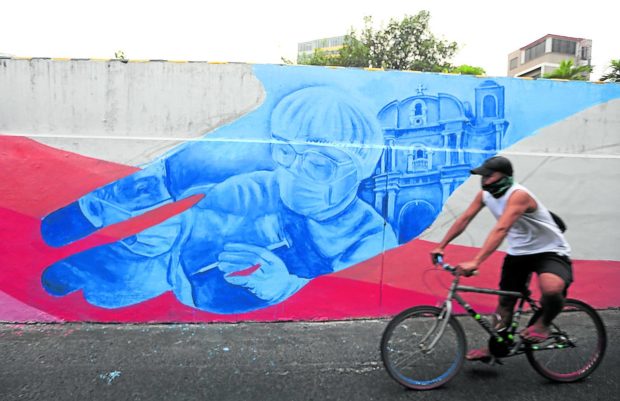
RECORD OF THE TIMES Hopefully, when the health crisis is over, a mural like this in Makati City and other similar pieces of public art will long remain, not to be painted over, as a stark reminder of a most trying time and of hard lessons learned. —NIÑO JESUS ORBETA
MANILA, Philippines — The Department of Health (DOH) is considering allowing self-administered or home testing for the coronavirus using antigen kits as COVID-19 cases continued to rise, shooting up to over 10,000 on Wednesday, nearly double the previous day’s count.
“We are waiting for the recommendation of our technical advisory group of experts. At present, antigen test kits are being used in a laboratory setup. It is not for home use yet,” Health Secretary Francisco Duque III said during a town hall event organized by Go Negosyo on Wednesday.
The recommendations will include guidelines to avoid any error in the interpretation of the test results by laymen, he said. “The demand is really great for this, admittedly, but we really have to educate our people how to do it correctly.”
Once approved by the experts, Duque said the Food and Drug Administration would amend the certificate of product registration on antigen test kits now available in the market, referring to the 32 that had been approved for use by the regulatory agency.
Epidemiologist Dr. John Wong told President Rodrigo Duterte during a meeting on Tuesday with Cabinet members and medical experts that, “because of the very fast transmission of Omicron, we need widespread use of antigen tests — even the cheaper ones are about P300 to P400 — so people have to be able to access these.”
Wong is a member of the technical working group on COVID-19 variants and technical working group on data analytics of the Inter-Agency Task Force for the Management of Emerging Infectious Diseases.
Experts to check first
In a press briefing on Wednesday, Cabinet Secretary Karlo Nograles, the acting presidential spokesperson, said test kits would have to be scrutinized by experts before any permit could be given to manufacturers “to make sure that the tests being used don’t give false negatives or even false positives.”
The DOH said almost 99 percent of the 10,775 cases it reported on Wednesday occurred within the last two weeks and majority, or 69 percent, were from Metro Manila. The other large numbers of cases came from Calabarzon and Central Luzon.
Since the COVID-19 pandemic struck in early 2020, Metro Manila has accounted for most of the largest numbers of daily cases in the country.
The last time the country saw more than 10,000 cases was on Oct. 10, 2021 when 12,159 new infections were reported.
According to the DOH, the current national positivity rate was 31.7 percent based on 44,643 people who were tested on Monday.
The positivity rate is the percentage of people found positive for the coronavirus out of the total number tested during a certain period.
The World Health Organization’s standard indicator that coronavirus transmission is under control is a positivity rate of 5 percent or below.
‘New high’ for Metro Manila
For Metro Manila, the positivity rate reached a “new high” of 40 percent on Jan. 3, according to the independent pandemic monitor OCTA Research group.
“It’s the highest that we have seen so far [since the pandemic started in 2020],” OCTA fellow Dr. Guido David said at Wednesday’s town hall meeting.
“I believe this is already straining our testing capacity, our testing laboratories. We have to augment this with antigen testing, which we are in fact doing so already,” he added.
Infectious disease expert Dr. Rontgene Solante supported the use of self-administered antigen test kits to speed up detection of COVID-19 cases “especially those with symptoms.”
“The advantage is, if you are symptomatic and you get the test and you are positive, you can isolate yourself, can do contact tracing early on, and prevent the transmission …. as compared to going out and having the RT-PCR,” he said.
RT-PCR is the reverse transcription polymerase chain reaction test, which the DOH considers as the “gold standard” for detecting SARS-CoV-2, the virus that causes COVID-19.
RT-PCR takes longer to produce results compared to antigen tests, which take only minutes.
‘Stay put’
Another infectious disease specialist, Dr. Edsel Salvana, also supported the use of home-administered test kits for the same reason cited by Solante.
Speaking at Nograles’ press briefing, Salvana also said that if vaccinated persons developed COVID-19 symptoms, there was a “low risk” that their condition would worsen.
“The most important thing really that you can do when you are symptomatic — especially if you only have mild symptoms and you are fully vaccinated, and the risk is low that you’re going to have severe symptoms — is really to stay put and not infect anybody else. Home isolate,” he said.
Some laboratories and local governments do home testing, and people who have mild symptoms could opt to consult doctors through telemedicine services, Salvana said.
Avoid packing hospitals
Wong also said that to avoid packing hospitals with so many patients, home care for mild cases should be encouraged and medicines for COVID-19 should be made affordable and administered on an outpatient basis.
The DOH case bulletin on Wednesday said that with the 10,775 new cases, the country’s total caseload was now 2,871,745.
It said that of the 39,974 active cases, 33,866 were mild, 1,294 asymptomatic, 3,983 moderate, 1,512 severe and 319 critical.
The DOH reported 605 recoveries, bringing the total number of survivors of the severe respiratory disease to 2,780,109.
The 58 COVID-19 fatalities raised the death toll to 51,662. But these deaths occurred between August and December last year and were only reported on Wednesday due to late encoding in the COVIDKAYA case collection system.
The new cases did not include figures from nine laboratories which failed to submit their test results.